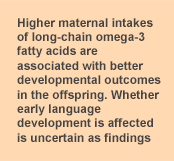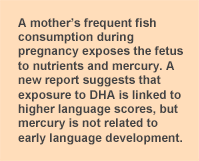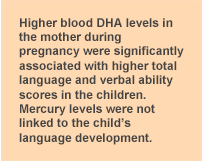
The importance of long-chain polyunsaturated fatty acids (PUFAs) in brain development and learning is well known. Less clear are the effects of these fatty acids on specific outcomes, such as language development. Some studies have reported no differences in vocabulary or language development with higher intake of long-chain PUFAs or DHA, a long-chain omega-3 PUFA. Others have observed transient effects of DHA supplementation in early infancy on later language development and some have reported improved language scores with higher levels of DHA in blood. Yet others have reported language deficits in children exposed to methylmercury in fetal and early life. It would appear that DHA or long-chain omega-3s have an uncertain place in language development or that mercury associated with eating seafood may be harmful to language development. What is really happening?

One of the best ways to answer this question is to follow the development of children whose mothers consumed large amounts of fish during pregnancy and thus were exposed to long-chain omega-3 fatty acids and mercury. Two such studies, one in the Faroe Islands and the other in the Seychelle Islands have conducted such studies. Results from the Faroe Islands have consistently reported detrimental effects on language, largely attributable to the children’s exposure to mercury during fetal life and infancy. This results from maternal consumption of pilot whale meat, which is especially high in mercury. When Faroe Island children whose mothers did not eat pilot whale were evaluated, there were developmental benefits associated with fish consumption without the harmful effects of mercury. So data from the Faroe Islands does not represent the effect of typical fish consumption in most countries. In contrast, results from the Seychelles Islands, where women eat 10 times more fish than in the U.S. and most Western countries, the offspring have consistently shown developmental benefits from high levels of long-chain omega-3s, even with exposure to mercury. In a new report from the Seychelles Islands, investigators examined the language development of children at 5 years of age. They collected information about the mothers’ consumption of omega-3 PUFAs and mercury and evaluated the children’s language development, verbal ability and intelligence scores.

When they analyzed the test scores for associations with mercury, taking into consideration the consumption of omega-3s, the investigators found no relationship between the language scores and exposure to mercury. Higher blood DHA levels in the mother during pregnancy were also significantly associated with higher total language and verbal ability scores in the children. The researchers also noted that higher levels of arachidonic acid, a long-chain omega-6 PUFA, were linked to lower language scores in all tests. These findings provide reassurance that eating plenty of fish, which provides appreciable amounts of long-chain omega-3 PUFAs, is associated with higher language scores in the offspring, even though the infant is exposed to mercury. In fact, the mothers’ hair mercury levels are 12 times higher than in the U.S., yet their children do not experience developmental deficits. The Seychelles Island data provide the strongest evidence available that the benefits of maternal fish consumption during pregnancy far outweigh the risks from mercury in the development of their offspring. This does not mean one should eat fish with high levels of mercury – one should not. But for pregnant and nursing women, consuming most fish species, which have only small amounts of mercury, such as most fish available in the marketplace and restaurants, does not pose a risk to children’s development. This study suggests that high levels of DHA from eating plenty of fish may also benefit the child’s language development.
 The importance of long-chain polyunsaturated fatty acids (PUFAs) in brain development and learning is well known. Less clear are the effects of these fatty acids on specific outcomes, such as language development. Some studies have reported no differences in vocabulary or language development with higher intake of long-chain PUFAs or DHA, a long-chain omega-3 PUFA. Others have observed transient effects of DHA supplementation in early infancy on later language development and some have reported improved language scores with higher levels of DHA in blood. Yet others have reported language deficits in children exposed to methylmercury in fetal and early life. It would appear that DHA or long-chain omega-3s have an uncertain place in language development or that mercury associated with eating seafood may be harmful to language development. What is really happening?
The importance of long-chain polyunsaturated fatty acids (PUFAs) in brain development and learning is well known. Less clear are the effects of these fatty acids on specific outcomes, such as language development. Some studies have reported no differences in vocabulary or language development with higher intake of long-chain PUFAs or DHA, a long-chain omega-3 PUFA. Others have observed transient effects of DHA supplementation in early infancy on later language development and some have reported improved language scores with higher levels of DHA in blood. Yet others have reported language deficits in children exposed to methylmercury in fetal and early life. It would appear that DHA or long-chain omega-3s have an uncertain place in language development or that mercury associated with eating seafood may be harmful to language development. What is really happening?  One of the best ways to answer this question is to follow the development of children whose mothers consumed large amounts of fish during pregnancy and thus were exposed to long-chain omega-3 fatty acids and mercury. Two such studies, one in the Faroe Islands and the other in the Seychelle Islands have conducted such studies. Results from the Faroe Islands have consistently reported detrimental effects on language, largely attributable to the children’s exposure to mercury during fetal life and infancy. This results from maternal consumption of pilot whale meat, which is especially high in mercury. When Faroe Island children whose mothers did not eat pilot whale were evaluated, there were developmental benefits associated with fish consumption without the harmful effects of mercury. So data from the Faroe Islands does not represent the effect of typical fish consumption in most countries. In contrast, results from the Seychelles Islands, where women eat 10 times more fish than in the U.S. and most Western countries, the offspring have consistently shown developmental benefits from high levels of long-chain omega-3s, even with exposure to mercury. In a new report from the Seychelles Islands, investigators examined the language development of children at 5 years of age. They collected information about the mothers’ consumption of omega-3 PUFAs and mercury and evaluated the children’s language development, verbal ability and intelligence scores.
One of the best ways to answer this question is to follow the development of children whose mothers consumed large amounts of fish during pregnancy and thus were exposed to long-chain omega-3 fatty acids and mercury. Two such studies, one in the Faroe Islands and the other in the Seychelle Islands have conducted such studies. Results from the Faroe Islands have consistently reported detrimental effects on language, largely attributable to the children’s exposure to mercury during fetal life and infancy. This results from maternal consumption of pilot whale meat, which is especially high in mercury. When Faroe Island children whose mothers did not eat pilot whale were evaluated, there were developmental benefits associated with fish consumption without the harmful effects of mercury. So data from the Faroe Islands does not represent the effect of typical fish consumption in most countries. In contrast, results from the Seychelles Islands, where women eat 10 times more fish than in the U.S. and most Western countries, the offspring have consistently shown developmental benefits from high levels of long-chain omega-3s, even with exposure to mercury. In a new report from the Seychelles Islands, investigators examined the language development of children at 5 years of age. They collected information about the mothers’ consumption of omega-3 PUFAs and mercury and evaluated the children’s language development, verbal ability and intelligence scores.  When they analyzed the test scores for associations with mercury, taking into consideration the consumption of omega-3s, the investigators found no relationship between the language scores and exposure to mercury. Higher blood DHA levels in the mother during pregnancy were also significantly associated with higher total language and verbal ability scores in the children. The researchers also noted that higher levels of arachidonic acid, a long-chain omega-6 PUFA, were linked to lower language scores in all tests. These findings provide reassurance that eating plenty of fish, which provides appreciable amounts of long-chain omega-3 PUFAs, is associated with higher language scores in the offspring, even though the infant is exposed to mercury. In fact, the mothers’ hair mercury levels are 12 times higher than in the U.S., yet their children do not experience developmental deficits. The Seychelles Island data provide the strongest evidence available that the benefits of maternal fish consumption during pregnancy far outweigh the risks from mercury in the development of their offspring. This does not mean one should eat fish with high levels of mercury – one should not. But for pregnant and nursing women, consuming most fish species, which have only small amounts of mercury, such as most fish available in the marketplace and restaurants, does not pose a risk to children’s development. This study suggests that high levels of DHA from eating plenty of fish may also benefit the child’s language development.
When they analyzed the test scores for associations with mercury, taking into consideration the consumption of omega-3s, the investigators found no relationship between the language scores and exposure to mercury. Higher blood DHA levels in the mother during pregnancy were also significantly associated with higher total language and verbal ability scores in the children. The researchers also noted that higher levels of arachidonic acid, a long-chain omega-6 PUFA, were linked to lower language scores in all tests. These findings provide reassurance that eating plenty of fish, which provides appreciable amounts of long-chain omega-3 PUFAs, is associated with higher language scores in the offspring, even though the infant is exposed to mercury. In fact, the mothers’ hair mercury levels are 12 times higher than in the U.S., yet their children do not experience developmental deficits. The Seychelles Island data provide the strongest evidence available that the benefits of maternal fish consumption during pregnancy far outweigh the risks from mercury in the development of their offspring. This does not mean one should eat fish with high levels of mercury – one should not. But for pregnant and nursing women, consuming most fish species, which have only small amounts of mercury, such as most fish available in the marketplace and restaurants, does not pose a risk to children’s development. This study suggests that high levels of DHA from eating plenty of fish may also benefit the child’s language development.

